Have you been writing blog posts for a while and not getting the desired results?
Does your blog seem like a lonely place to hang out, and your blog has no fans?
If yes, then it’s a thing to worry about, and there is something wrong you might be doing with your blog posts.
Well, Don’t worry, I’ve been there too; when I started blogging, I didn’t know how to write fantastic content, heck I didn’t even know the basics back then.
But with time, I’ve become good at writing Content that my readers love.
And in this blog post, I’m going to teach you the same formula, How to write a blog post that people will love to read and which will bring better conversions to your blog.
So let’s get started.
Before we begin, it’s first necessary to understand a Good Blog post.
What is a Good Blog Post?
My definition of a good blog post would be:
- A blog post that solves my reader’s problems in one go so that they won’t have to look for another resource, article, or video after reading my content.
- Giving them the information they are looking for As quickly as possible.
- A blog post that is interesting to read and keeps them engaged.
- A blog post that doesn’t waste my reader’s time.
That’s what a good blog post is to me.
And in this blog post, you’ll learn the exact step-by-step process I follow to craft a fantastic blog article.
How to Write a Blog Post?
So for writing a good blog post, you need to follow some of the basic yet effective rules of writing that all professional Bloggers follow.
So Let me show you what they are.
Step 1 – Research The Topic That You Are Going to Write

This is the first step of writing a blog article; you should know what to write before you even start writing.
If you already have a topic you will write about, then well and good, but most people don’t have it in the first place.
Here are some places to get inspiration for your next blog post.
- Quora – Quora is a goldmine for bloggers; it’s a question-and-answer platform where you can find lots of questions related to your niche, find the questions that have been asked the most (Burning hot questions), the topic which people care about the most in your niche and create a blog post for it.
- Facebook Groups – There are Facebook groups related to every different niche, and the best part about Facebook groups is that people ask questions, answer questions and share valuable knowledge there; you can find a good Facebook group related to your niche and observe all of the different questions people ask and pick the most common ones and create a blog post for each one of the question.
- Reddit is where you can find the most trending and hot topics related to your niche.
- YouTube – YouTube can’t be ignored when it comes to getting ideas for our blog posts; there are YouTubers and YouTube Channels Related to any of the different niches you can think of, and you can get ideas for your next blog post from those youtube channels quickly.
Also Read: How to Find a Profitable Niche For Your Blog (Proven Method)
After you’ve researched the topic you want to write about, it’s time to find out the keywords that people search for related to that topic.
Step 2 – Find a Main Keyword And LSI Keywords Related to Your Topic

Keywords are the phrases people type in search engines like Google to find the desired content or solutions for their problems or their Queries.
Why It’s Important to Have Keywords?
Search engines like Google scan your content for the relevant, related terms and keywords in your article that real people search to provide them with the best possible results.
And if your article has keywords and phrases that people search for, your report will be ranked in search engines, which will help you bring more organic traffic to your blog.
How Many Types Of Keywords are There? And which Keyword to Target in your Article?
Essentially there are 3 Types of Keywords.
- Short Tail Keywords (Having one or two words in them)
- Mid Tail Keywords (Having three words in them)
- Long Tail Keywords (Having more than 3 words in them)
- LSI Keywords (Keywords related to your Main keyword)

What type of keywords are most profitable to go after?
Long-tail keywords and LSI Keywords are the most profitable keywords to go after because they are more specific and targeted, and the conversion rate of Long tail keywords is very high compared to short-tail and mid-tail keywords.
Although short-tail and mid-tail keywords have more search volume than long-tail ones, the most money-making keywords are in the long-tail ones because they are more specific and targeted.
What are LSI Keywords?
LSI keywords or (Latent Semantic Indexing) are the keywords related to the main keyword you are targeting in your content.
LSI keywords also help you rank for multiple different keywords from one content.
LSI keywords help Google and other search engines understand more about your content.
For example: whenever someone types in the word “APPLE” in search engines, then the person might be looking for Apple fruit or Apple company.
So here is where LSI keywords come into the picture.
When you write content about Apple Fruit, then you will include words like “Health benefits,” “Doctor”, “Good for health,” etc., which are indirectly related to Apple fruit.
And when you write content About Apple as a technology company, then you will include keywords like “Steve Jobs,” “iPhone”, “MAC”, “Apple Computers,” etc.
So LSI keywords help add relevant value to your content, and it helps search engines determine what your content is about.
Let me give you another Example:
Have you ever wondered how whenever a user types in “Window” in search engines, the search engine shows the window the person is talking about?
Here is where LSI keywords come into the picture.
If the person is talking about the Windows Operating system, you have to include LSI keywords related to the Windows operating system; you have to include keywords in your content like “How to Install Widows”, “How to Activate windows,” etc.
And on the other hand, if the person wants to get information about windows that we have in homes, then you should talk about “curtains,” “Windows Door”, “Windows for the roof,” etc. This will help search engines understand your content in a better way.
LSI keywords can be found using any keyword research tool like Ahrefs, SEMrush, Ubersuggest, Kwfinder, and even Google too can be used to find LSI keywords.
Use these tools, and you will find lots of related LSI keywords for your content, and add those LSI keywords to your content wherever possible this will increase the relevancy of your content.
I prefer to use SEMrush to find LSI Keywords for my Blog posts because it saves me a lot of time.
Where to find the Long Tail and LSI Keywords For Your Blog Post?
Finding keywords is very easy; you can use any keyword research tool to find keywords.
Here are some keyword research tools that can help you find keywords.
- Ubersuggest
- Ahrefs
- SEMrush (This is what I prefer because of its accuracy)
- Google Autosuggest & Related Keywords
Now I Will Show you 2 methods of finding highly profitable Keywords for your blog posts.
1. Finding Keywords With SEMrush
Let’s look at How I Find these Easy to rank LSI Keywords for my Blog Posts using SEMrush.
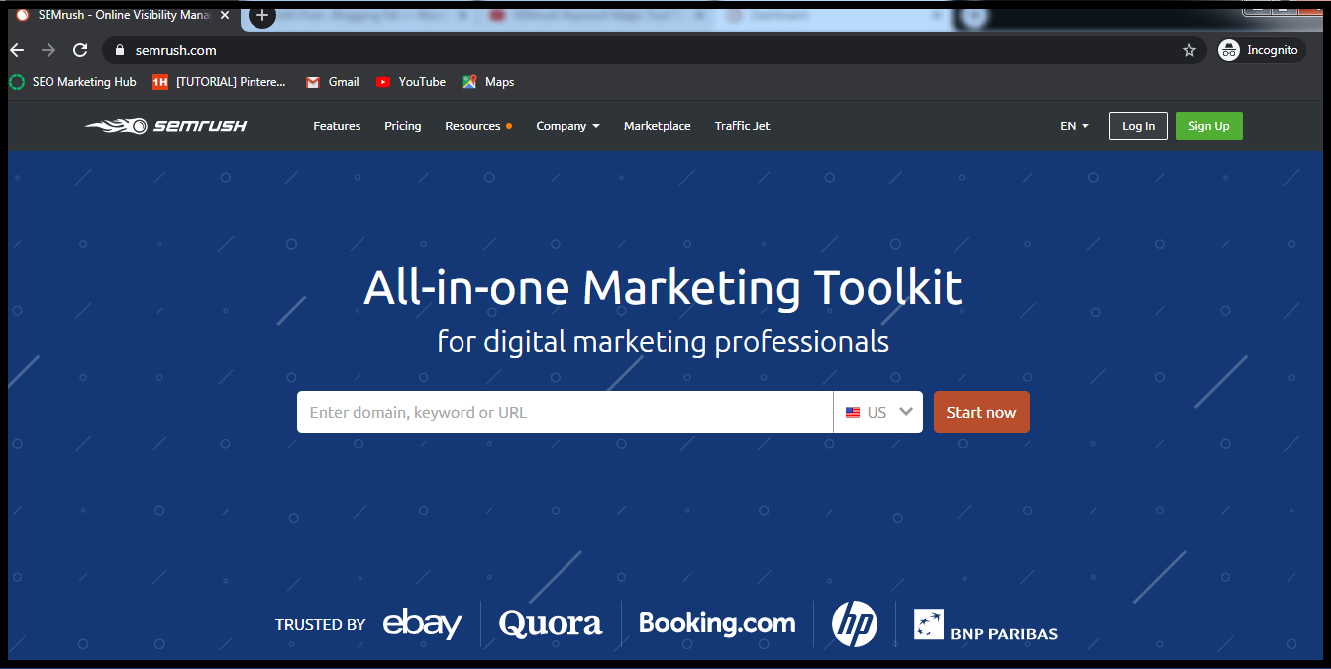
SEMrush is an all-in-one marketing tool that can help you with all your marketing efforts like SEO, Paid Advertisements, and other marketing all kinds of stuff.
But today, we will be mainly focusing on finding easy-to-rank LSI Keywords.
First, Open the Keyword Magic tool of SEMrush and type in any seed keyword for which you want to find LSI keywords.
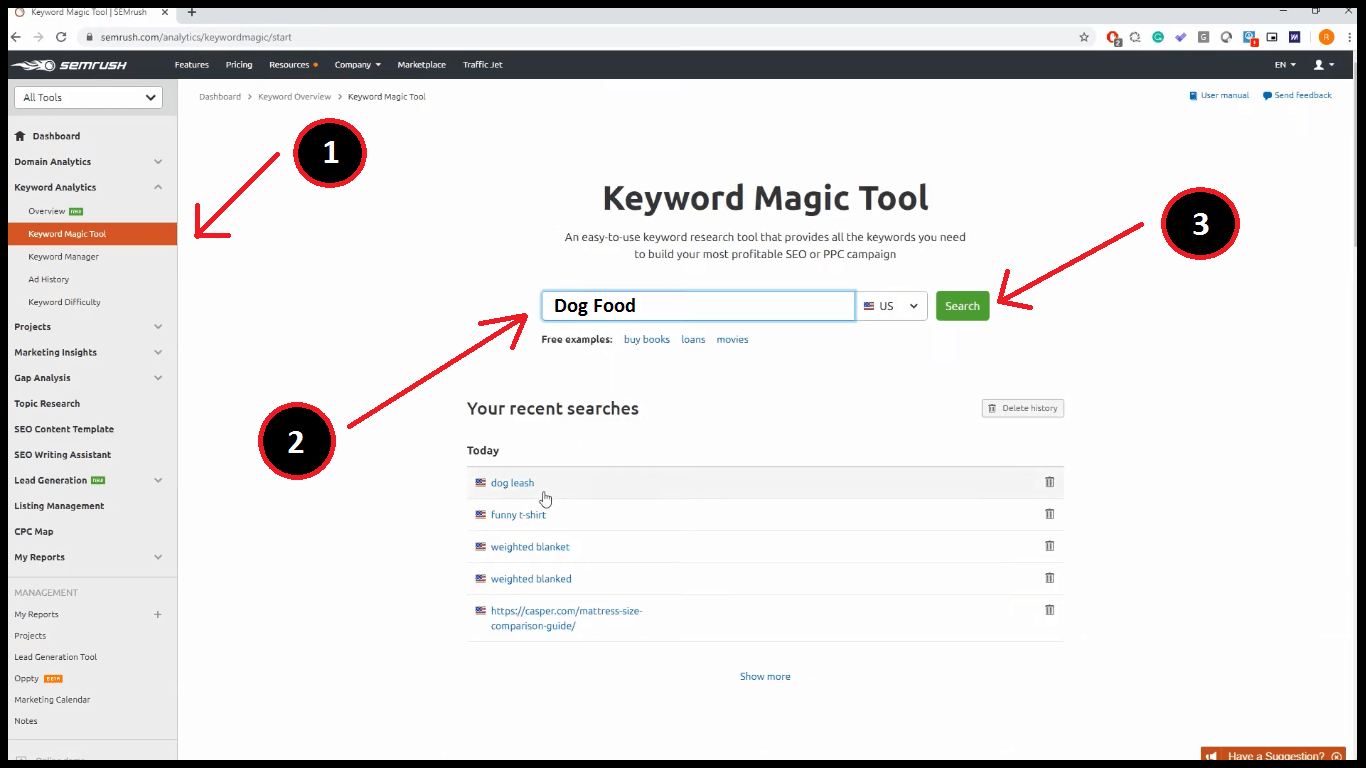
Then SEMrush Keyword Magic tool will show all the Good keywords related to the keyword you searched for.
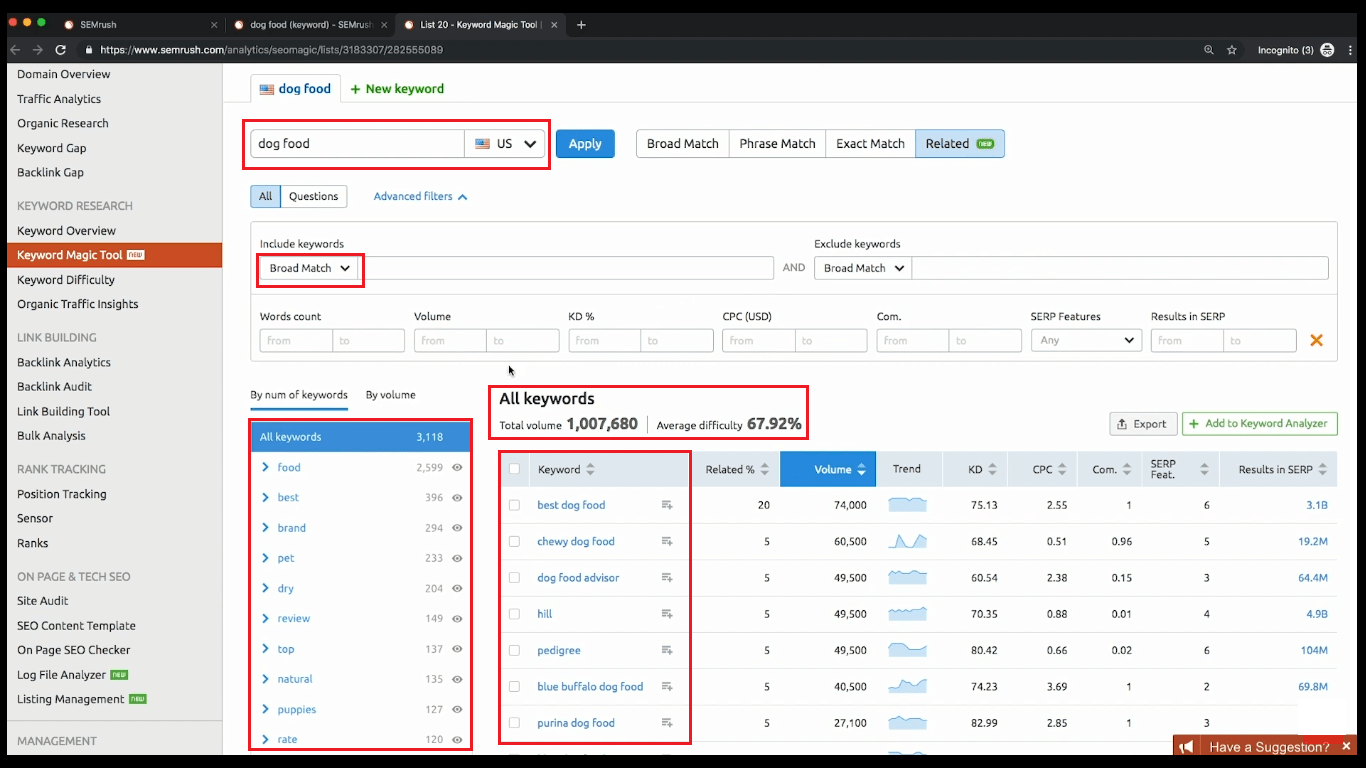
As you can see from the above image, SEMrush has given us lots of keywords related to “Dog Food” there are lots of keywords that are very short tail and which are not useful for us on the above list, so we will filter out all the unnecessary keywords.
Now see the beauty of the SEMrush Keyword Magic tool; it has an option called Advanced Filters, which will help us filter out keywords according to our needs and help us find all the LSI keywords.
The Advanced filter has 7 different options, which help us filter out unnecessary keywords easily.
The advanced filters include parameters like.
- Word count
- Volume
- KD%
- CPC
- Competition
- SERP features
- Results in SERP
Here is what you should apply to filter 👇

Set Word Count = 4
Set Search Volume = 100 – 2000
Set KD% = 10% – 70%
After that, click on Apply Filters
After you apply the filter, you will be left with all the profitable easy-to-rank long-tail keywords.
These keywords are golden nuggets; if you use them in your content, it’s guaranteed to give you positive results.
These LSI keywords are very profitable and easy to rank.
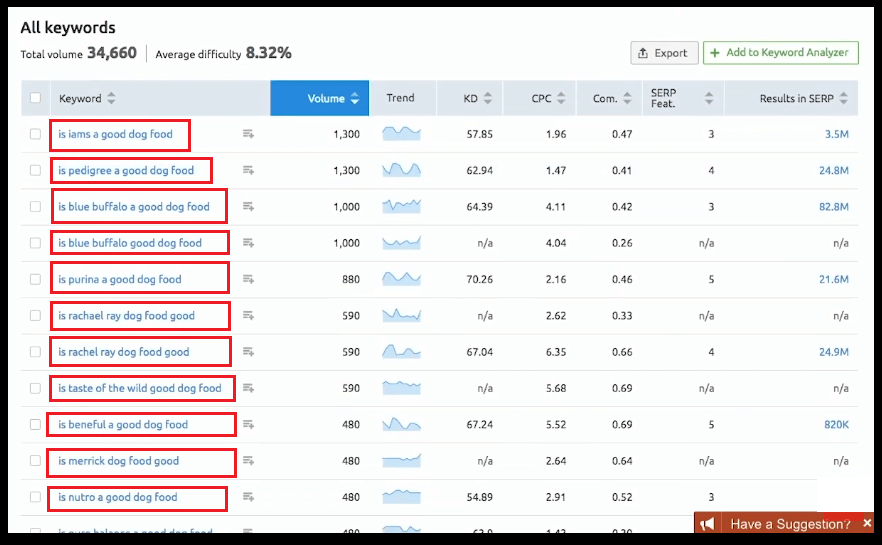
?
How To Use SEMrush For FREE?
If you want to Use SEMrush For FREE, then I can help you access their Guru Plan FREE For 7 Days, which costs $199.95 Per Month, but you can get it for 7 days.
This will help you get your hands on this tool and understand it even better. It will also help you collect Lots of Profitable easy-to-rank LSI Keywords for your blog post.
Step 1: Click On this Exclusive 7 Days Trial Link This will take you to the FREE trial Signup Page from where you can activate your 7 days FREE trial of SEMrush. (Screenshot attached Below)
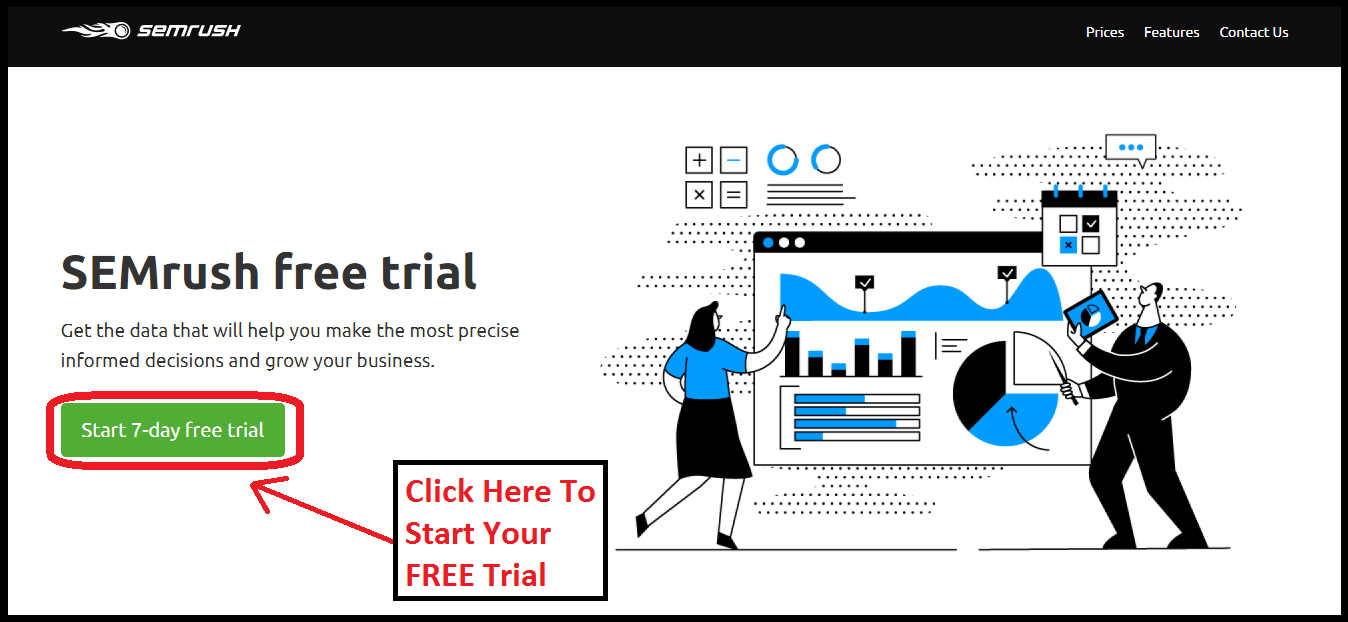
Step 2: Next, you will be taken to a page where you have to set up your SEMrush account and sign up with your email address and password. (Screenshot attached below)
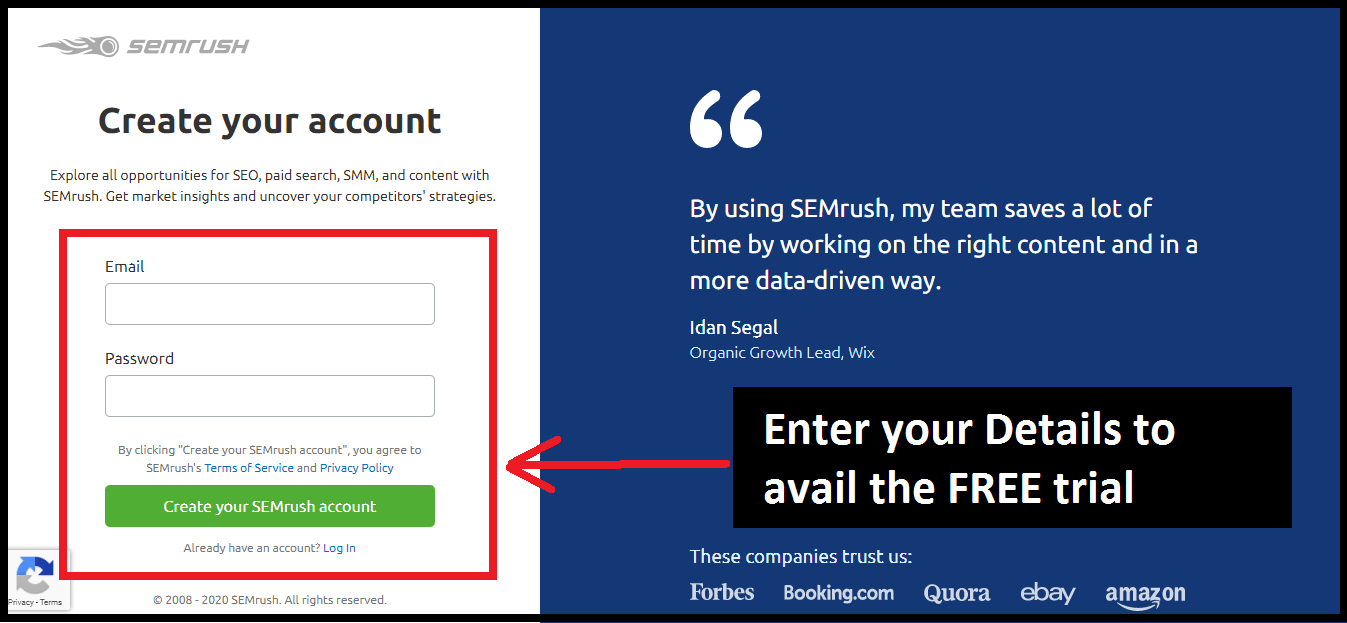
Step 3: After that, you will be taken to the next page, where you will be given a choice to select the SEMrush plan for the FREE Trial. Select GURU Plan From there, as this plan will provide you with more features and Flexibility.
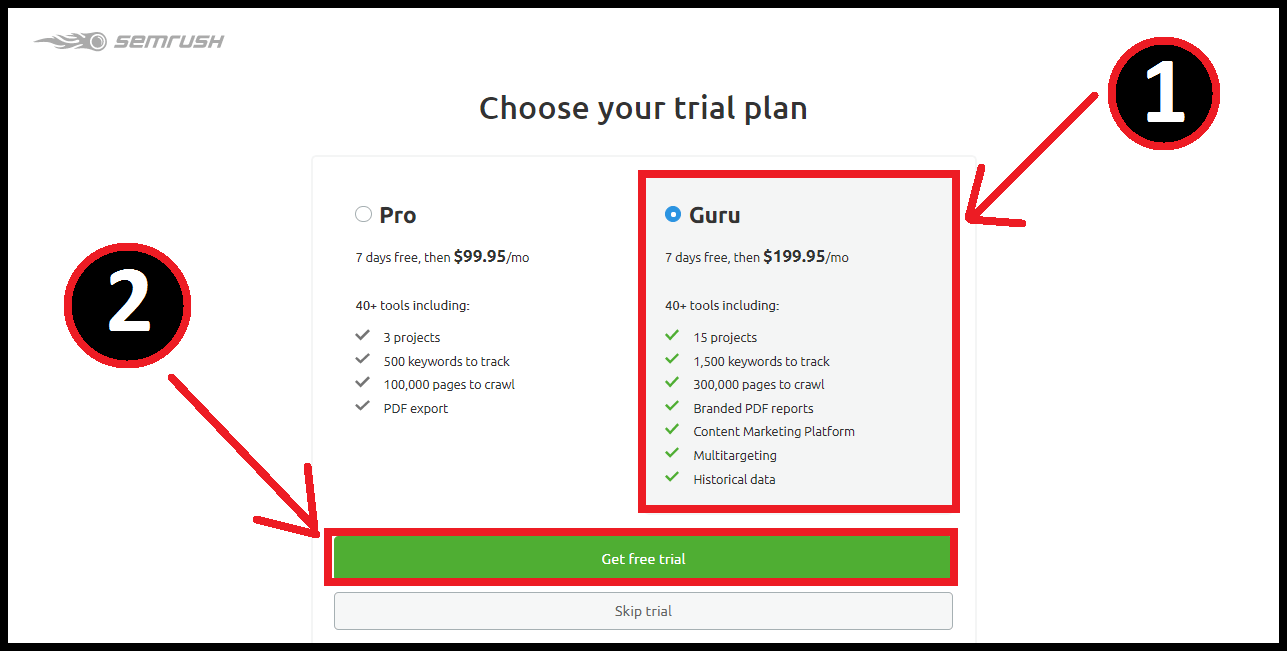
Step 4: After that, click on the Get FREE Trial Button, and then you will be taken to the Checkout page, where you will have to Enter your Credit card/Debit Card Information, Don’t worry. The FREE trial will be FREE For 7 days, and you can cancel anytime.
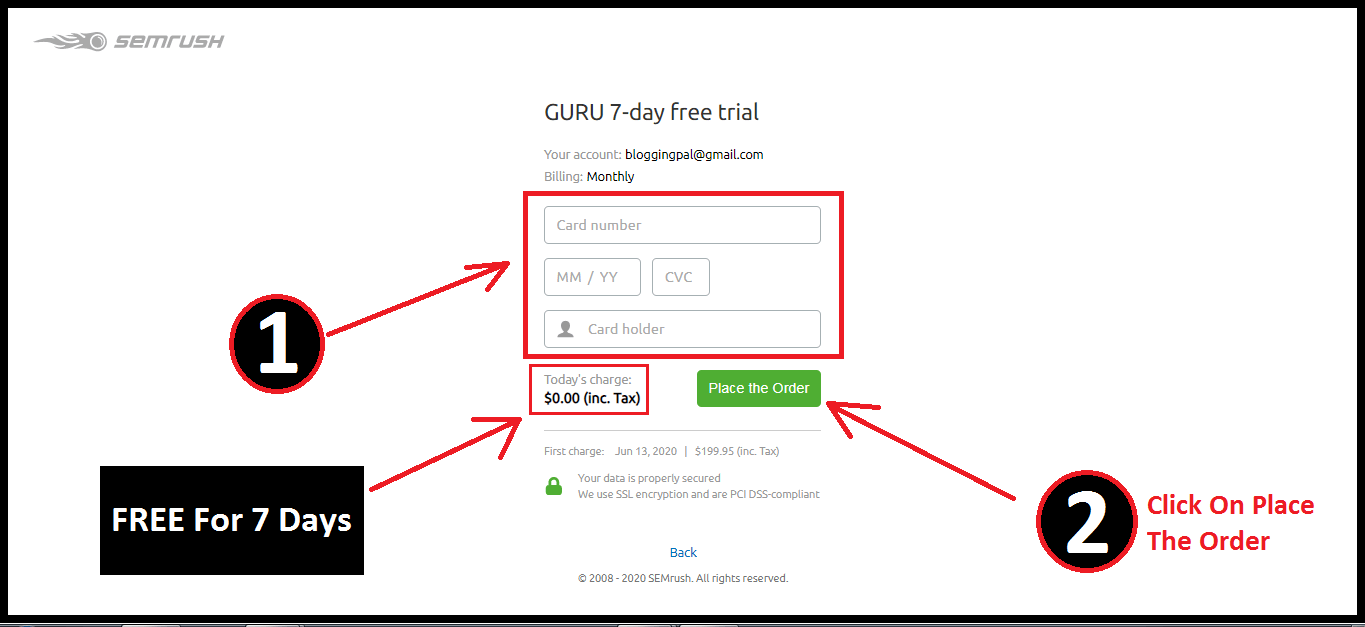
And I’m sure you will love the SEMrush SEO tool just like me; you will find tons of great keywords from SEMrush.
Personally, I have found many keywords using SEMrush, which showed excellent results for my website and that is why I recommend SEMrush to all my readers.
SEMrush Marketing Tool
Get FREE For 7 Days
The above method is the best method to find LSI keywords to target in your content; it saves you time, and it helps you see all those easy to rank and are very profitable, and working on them will give you great results.
2. Finding Keywords With Ubersuggest
Here’s how you can find Keywords for your Blog Post with the help of a FREE tool called Ubersuggest.
- Go to Ubersuggest and type in the main topic that you want to write about.
- Select your target country and search.
- It will show all the data metrics related to that keyword like search volume, CPC, and Difficulty of that keyword.
- So select the main keyword if the keyword has a good search volume and a fair amount of difficulty that you can compete.
- Scroll down, and you will find many other related keywords related to that keyword.
- Copy 8-10 related keywords into your spreadsheet, and you will be good to go.



Copy The Main Keyword And The Related Keywords in a Spreadsheet

Collect 5 – 10 easy-to-rank keywords and relevant keywords to target in your article, and you’ll be good to go.
PRO TIP: Only select keywords that are easy to rank and whose search difficulty is less than 30 or near 30, don’t go for a high-difficulty keyword. As a beginner,r you will not be able to compete for those keywords.
Step 3 – Understand The Main Intent Behind The Keyword That You Want to Target

Understanding the intent behind the keyword is very important because it helps us to shape our article for our readers in a better way.
Search intent means finding out why a person is searching for that keyword and the intention behind that keyword. And present the best possible Article you can for that query.
There are 4 types of intent and intent, and every keyword has a different intent behind them.
- Informational intent (People looking for some information)
- Navigational intent (People Navigating to a website)
- Commercial intent (People looking for the best products)
- Transactional intention (People looking to buy something)
Example: If you want to target the keyword “How to cook rice,” then clearly, it’s an informational intent keyword, and the searcher is looking for some tips on cooking rice.
Deliver the best possible solution to that problem, and your article will rank high on search engines and get lots of traffic.
PRO TIP: Search the word on Google’s top 10 ranking sites, analyze the content they have written, what they are missing, etc, and make a 2X more valuable piece of content than theirs.
Now Moving on to Our Next Step in Writing a Blog Post.
Step 4 – Create a Layout For Your Blog Article
After you have researched your Content, Got your list of keywords, now you should have a pretty good understanding of what your readers want from your article.
Now you should create your layout of the article to deliver the content.
Here’s The Typical Blog Layout of a Blog Post.

Add an Intro, Subheadings, and conclusion to complete your blog post.
Structure your Blog Post’s layout according to the research you have done and the data you have collected, and create a better version of the content than what’s existing.
Now let’s move on to our next set,p, which is…
Step 5 – Come Up With a Powerful Headline For Your Blog Post

A Powerful Headline is what grabs your reader’s attention in one go.
A good headline should make your readers stop and click through your article.
Some Quick Tips For Crafting Great Headlines
- Tease what you’re going to deliver in the article but don’t tell the whole story in the title.
- Create your titles so that your readers would want to click on them and could never resist reading.
- Create curiosity in your reader’s minds so they will want to know more.
- If possible, Add an Odd number to your article. It makes your title super attractive and clickable.
- Adding dates in the article makes your readers think it’s a fresh article – always put updated dates.
- The headline should also be short and crisp.
- You can use a tool like Coschedule Headline Analyzer to check how powerful your headline is and what the chances are of your title being a success.

Step 6 – Create an Eye-Catching Featured Image

Featured images are the first thing your readers will notice when they land on your blog post, and after that, they will read the title and decide whether to read further or not.
So it’s imperative to create an eye-catching featured image.
I use Canva for Creating featured images for my blog post,s and it’s FREE.
Step 7 – Write an Award Winning Introduction

If your blog post’s introduction manages to win the heart of your blog readers, then they will indeed read your full blog post.
An introduction should be short, crisp, and to the point and give your readers a preview of what they are going to get by reading your article.
Go and read the introduction part of this very blog post you’re reading right now; you will understand why it’s important to have a good introduction.
Tell your readers they have a problem; tell them where they are and what they are going to achieve after reading your entire blog post; that’s the key to writing an awesome introduction.
Step 8 – Write The Content

Content is the most important part of your blog post; without it your headlines, titles, and good images, nothing will work.
Everything will go to waste if you don’t have helpful content for your readers.
And you might have already heard a famous Quote, “Content is King“.
Do you Remember the outline creation part?
We will use the same outline for creating content.
Fill out all those subheadings you have made inside your outline and create a valuable piece of content.
Create 2x more valuable and actionable content than your Competitors.
Because at the end of the day, we are all competing against someone to get more views of our content.
PRO TIP: Sit down in a quiet environment and write the content; this instant hack will make you more creative while writing your content, and you can write a much better piece of content in this way.
Step 9 – Make Your Blog Post Appealing to The Eyes of Your Reader

Creating an appealing blog post is an art; those who master this art can create highly engaging content.
Here are some of the tips that I use to create amazing, jaw-dropping, Visually appealing content, and these tips would make your content extremely scannable.
1. Use short paragraphs
Shorter paragraphs are easier to read as compared to big lengthy blocks of text.
So you should consider making your paragraphs shorter. It will instantly make your article more readable, and people will love to read your blog posts.
2. Use bullet Points and Numbering
Bullet points and numbering help us to make attractive points and list down all the important checklists that we have.
3. Bold, Italic, and Underline important words
Bold, Italic, and Underline important words within your article to pinpoint important words and phrases; this will help your readers to focus on what’s important.
4. Create visually appealing images
One image can indeed say 1000 words.
Create visually appealing images for your blog posts that will help your readers to understand better what you are explaining.
And if there’s a video that you can embed, then make sure you add a video there.
I use Canva to create all the images for my blog post
Step 10 – Focus on Quality, Not Quantity

Sometimes people think that the more words their blog post has, the better it is for the readers.
Let me bust this myth for you: the more fluff your write in your article, the more your readers are likely to bounce off your article.
So only write what’s important and don’t just unnecessarily put in what looks cool which doesn’t add any value to the article.
Even if your article is short but it has to be valuable, crisp, and useful to the reader.
Think of it this way: Your reader is not reading your content because he wants to read content; he’s reading your content because he wants a solution for his problem.
Step 11 – Write in Easily Understandable Language

Write in such a way that even a 5th-grade child should be able to read and understand your content.
People think that having complex jargon and complex words makes their article good, but this is completely wrong.
What’s the point of writing something that only an Oxford scholar can read and understand?
That’s completely wasting your time behind something which will never take off.
So it’s very important to write your content in extremely simple words that everyone who is reading your content can understand.
Step 12 – Insert a Call to Action at The End of Blog Posts

CTA or “call to action,” is the most important element of any blog post you write.
CTA’s encourage your blog readers to take a specific action at the end of your blog post.
CTA’s are usually placed at the end of the blog post so that you can persuade them to take any action.
It could be anything like signing up for your email newsletters or purchasing any product, or asking them to take any action.
Step 13 – End With a Strong Conclusion or a Closing Remark

The conclusion sums up your whole blog post and gives your readers a 10,000-foot overview of what they just read in your blog post.
It should be short and to the point which tells your readers what they have learned and what they need to do next.
Step 14 – Proofread Once You Have Written Your Blog Post

Proofreading is the process of reading your blog post to discover all the errors and grammatical mistakes after you finish writing your article.
Many online tools can help you proofread your content.
I use Grammarly to proofread my Content; it’s an online grammar and punctuation checker tool that helps us find and correct any errors in our written copy.
Step 15 – Optimize For SEO using the RankMath SEO plugin
After you have written your blog post, you should Optimize your blog posts for SEO to make sure you get maximum search engine attraction from Google and other search engines.
Search engine traffic is the most valuable traffic for any blog, so we shouldn’t undervalue SEO.
I use a plugin called the RankMath SEO plugin to make my work easier.
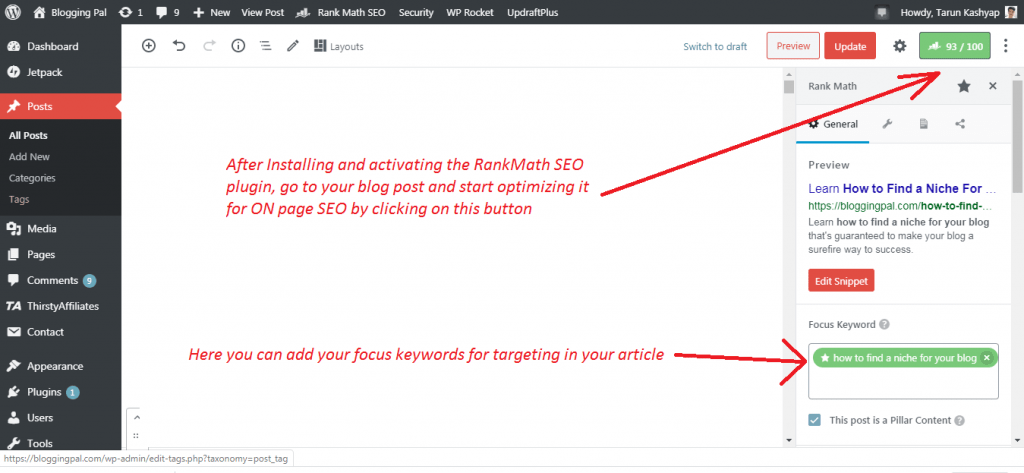
Rankmath SEO helps our WordPress blogs to make our content ON page SEO optimized.
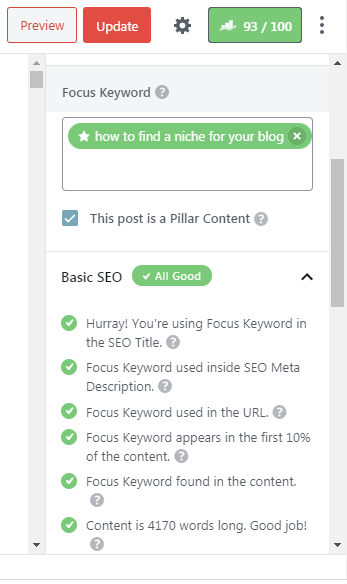
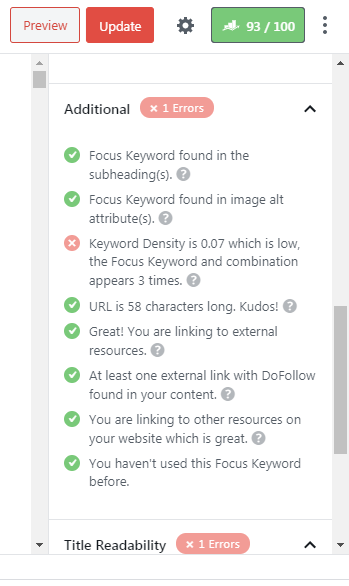
Rankmath has its predefined checklist that ensures we are on the right path for writing a perfect ON-page SEO-optimized article.
Step 16 – Add a FAQ Section Below Your Blog Posts

FAQs are the most frequently asked question related to your topic.
We should add these frequently asked questions because it makes our blog article more relevant to the searcher’s query.
And adding FAQs also helps our article for voice search optimization
Where Can You Find These Questions?
There is a great tool called Answer The Public; it shows all the questions and phrases people ask for in the search engines for your entered topic.
Another great tool for finding questions related to your topic is questiondb.io
Use the above-mentioned tools for funding questions you can include in your blog post.
A quick tip: Don’t include more than 4 FAQs in a blog post.
Step 17 – Write Naturally

Many people try to write in someone else’s tone, which doesn’t suit them well, and later on, they end up not writing anymore because they don’t feel like writing.
The main reason behind not feeling like writing anymore is because they write in someone else’s tone, which they naturally find difficult to write.
Everyone has their unique style of writing, which is different for every individual, and the easiest style that you can write is to Write in your tone.
When you write in your tone, you will feel like writing more and more without getting frustrated.
Bonus ⭐ Some Additional Tips For Writing an Amazing Blog Post
- Your blog’s font selection should be excellent and readable so readers find it more readable.
- Make sure your blog posts look good on a mobile device too.
- Don’t be a perfectionist when writing blog posts; write what you know, and don’t copy others; nobody is perfect in this world, everyone starts from 0, and everyone’s first blog posts suck.
- Writing good blog posts is an art, and you will only get better at it day by day if you practice writing daily and make time for Blogging.
- Deliver what you promised in the title or subheading, don’t mix the topics, and write with clarity.
- Before you start writing your content, put yourself in the shoes of your target reader, try to understand their pain points and what they are struggling with, and figure out How you can help them.
- After you have finished writing your content, add your content to the relevant category and tags to your content – it helps make your article relevant to the searcher’s query.
- Use the AIDA Digital Marketing funnel rule (Google it) to write the best content; this will help you take your readers from the Awareness stage to the Action stage.
Conclusion
Thus there you have it—a guide to creating blog posts that people will adore.
Moreover, suppose you continue to deliver valuable posts, then over time. In that case, they will advocate for your blog’s content and do all sorts of different things for you, like sharing your content on social media, linking to your content, and buying from your affiliate links, etc.
Also, Read 17 Different Types Of Blog Posts Every Blogger Must Write For His Blog.
Now it’s your turn to go to your blog and create the best content for your readers.

Some FAQs Related to Writing Blog Posts
How long does it take to write a blog post
It depends upon the topic you are writing about, some topics can be explained in less no than words, and some topics take more words to describe, and according to that, it takes time more or less.
What should I write a blog post about?
You should write blog posts on topics related to your niche.
How often should you post on Blogs?
It depends on the quality; if you can bring in consistent quality blog posts, you can post as much as you want.
What is the best platform for BLogging?
WordPress is the most popular and best platform for blogging.
